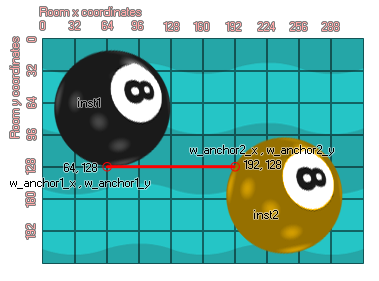
physics_joint_rope_create(inst1, inst2, w_anchor1_x, w_anchor1_y, w_anchor2_x, w_anchor2_y, maxlength, col)
| Argument | Description |
|---|---|
| inst1 | The first instance to connect with the joint |
| inst2 | The second instance to connect with the joint |
| w_anchor1_x | The first x coordinate for the joint, within the game world |
| w_anchor1_y | The first y coordinate for the joint, within the game world |
| w_anchor2_x | The second x coordinate for the joint, within the game world |
| w_anchor2_y | the second y coordinate for the joint, within the game world |
| maxlength | The maximum length that the joint can "stretch" |
| col | Whether the two instances can collide (true) or not (false) |
Returns: Index of the joint
A rope joint is one which is used to join two instances that you
want to keep a constant distance apart, no matter what other forces
are acting on it. With a distance joint, you can get "joint
stretching" where the two fixtures will sperate and behave
strangely should too much stress be put on the joint, however the
rope joint does not do this and will not stretch any further than
the maximum defined length. When you create a rope joint the two
instances should already be created and have a fixture assigned,
then you define the two anchor points in room coordinates. The
first anchor point is connected to instance 1, the second anchor
point is connected to instance 2 and the distance and the maxlength
argument sets the maximum length constraint on the joint. The image
below shows how this works:

As you can see, the anchor points are specified as room
coordinates so care must be taken when defining them, especially if
the instances are being created at the same time as the joints
rather than being placed in the room through the room editor. You
should also realise that the joints are created independently of
the size of the sprite of the instances or the fixtures they have
attached. So, if you create a rope joint somewhere other than the
origin of the instance, it is still valid and will constrain the
two instances relative to the position at which it was created. If
you set the "col" value to true then the two instances can
interact and collide with each other but only if they have
collision events, however if it is set to false, they will
not collide no matter what.
var mainFixture, o_id;
mainFixture = physics_fixture_create();
physics_fixture_set_circle_shape(mainFixture,
sprite_get_width(sprite_index) / 2);
o_id=instance_create(x+300, y, obj_Rudder);
physics_fixture_bind(mainFixture, id);
physics_fixture_bind(mainFixture, o_id);
physics_joint_rope_create(id, o_id, x + 50, y, o_id.x - 50, o_id.y,
300, 0);
physics_fixture_delete(mainFixture);
The above code creates and defines a new fixture and then creates an instance of "obj_Rudder". The fixture is then assigned to the instance that is running the code as well as the newly created one and a rope joint is created between them. Finally the fixture is deleted as it is no longer needed.